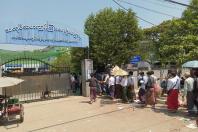The collapse of saddle dam D at the Xe-Pian Xe-Namnoy hydroelectric power project in Attapeu province last year was not considered as “force majeure”, a senior government official said yesterday.
Vice President of the National Investigation Committee (NIC) formed by the government to investigate the cause of the disaster, which killed dozens of villagers and left thousands homeless, revealed the findings of the investigation at a press conference.
Mr Singphet Bounsavatthiphanh said that even if rainfall was quite heavy on the days before the July 23, 2018 failure, the reservoir level was still below the maximum operation level and well below the crest level when the failure started.
“Thus, the failure incident cannot be considered as ‘force majeure’,” he told local media at the Prime Minister’s Office.
The government set up the National Investigation Committee to thoroughly investigate, verify and report to the government, the general public, the international community and other stakeholders with regard to the underlying causes of the collapse of the saddle dam.
To ensure the integrity, reliability, impartiality and transparency of the investigation and the accurate determination of the causes of the collapse, the Committee engaged and gave full authority to a panel of professional and independent experts (the Independent Expert Panel, or IEP) with globally recognised reputations to conduct an independent investigation and to report the results of that investigation.
The IEP‘s members are Professor Anton J. Schleiss of Switzerland, Honorary President of the International Commission on Large Dams (ICOLD), Mr Ahmed F. Chraibi of Morocco, former Vice President of ICOLD, and Dr Jean-Pierre Tournier of Canada, a Vice President of ICOLD.
ICOLD is widely recognised as the world's leading professional organisation dedicated to advancing the art and science of dam engineering.
In addition, the government invited foreign parties to take part as observers in the investigation process.
The government understands that the Korean company involved in the development of the project is also carrying out an investigation into the underlying causes of the collapse.
The investigation conducted by the IEP was based upon the supporting information available, the IEP's observations made over the course of three site visits conducted since August 2018, and the results of the recommended post-failure geotechnical investigations.
The IEP outlined its findings on the failure of saddle dam D in a final report, and submitted that report to the NIC on March 20, 2019, according to Mr Singphet, who is Vice President of the Government Inspection Authority.
The IEP found that the failure could not be considered as “force majeure” as explained above.
It also found that the root cause of the failure was related to high permeability combined with erodible horizons mainly due to the existence of canaliculus interconnected paths. As the water level rose during the filling of the reservoir, seepage flow developed in the foundation along these paths and horizons with high permeability. This resulted in internal erosion and softening of the laterite soil. When erosion and softening in the foundations reached a certain point, the dam stability was no longer ensured and a deep rotational sliding at the highest section of the saddle dam was triggered.
This finally led to complete breaching of the saddle dam and its foundations, resulting in the catastrophic uncontrolled release of water from the reservoir.
According to the Independent Expert Panel, the foundation is without doubt involved in the failure, which could have been prevented by adequate treatment measures.
http://www.vientianetimes.org.la/freeContent/FreeConten_Investigators.php










